You’re carrying your baby, and then you find yellow, crusty, and greasy flakes on your baby’s head. While it may seem something to panic about, don’t worry because this isn’t lethal or dangerous. This health concern on babies is termed as the “cradle cap.” Medical professionals would call it infantile seborrheic dermatitis, though.
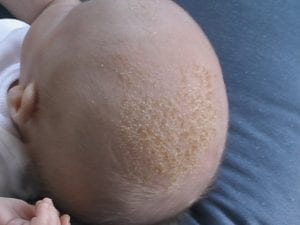
No one knows much about it, even among doctors and pediatricians. But one thing people do know is that the issue can be treated. So let us now understand cradle cap causes and treatments.
Understanding Cradle Cap
When greasy and scale areas appear and amass on an infant’s head, it is a skin issue called cradle cap. The cap area can either be yellowish or reddish. Due to this, some people mistake it as rashes. These scales can appear along with dandruff and other problems like eczema (read more details on this page).
Who Are Affected By It
The babies usually affected by this are aged three weeks to two months. Once the child is a year old, the skin condition often goes away, but there might be cases that are exemptions. At times, some toddlers even experience it. This condition can affect different skin types too.
Duration Of The Scalp Issue On Babies

The length by which the cradle cap appears will differ. The range is broad to the point that it can go away after weeks, or it can go away after months. If the condition is more severe, and if there is dandruff or eczema present, the cradle cap may persist and is not easy to go away. Treatment is necessary.
The Causes Of Cradle Cap
Though the exact cause of the cradle cap hasn’t be pinpointed yet, there are several theories about it.
Excessive Sebum Production: When the baby produces too much sebum or oil on the area, the scalp may become too greasy. This overproduction of sebum can also be caused by hormones that came from the mother by the time the baby was still in the womb. It is one of the cradle cap causes being looked into.
Shedding And Hardened Dead Skin: You have probably already experienced peeling off the old and dead skin. The same thing can also happen to babies. But sometimes these dead skins can harden and thus form what is now known as the cradle cap.
Infection: Bacteria can also cause an infection, which in turn can lead to the dead skin to mount up in the scalp. Fungus-like yeast can also infect the sebaceous glands, which then cause seborrhea.
The skin issue may be terrible to look at, but there’s no need to worry too much. It isn’t dangerous, and it isn’t contagious either. The baby also won’t feel itchy because of it, and it won’t cause any allergies. Once it goes away, it also won’t leave any scar. It may seem scary, but by understanding the symptoms, your inner self can be calmed.
Signs And Symptoms Of Cradle Cap
If your baby has the cradle cap, here are some visible signs:
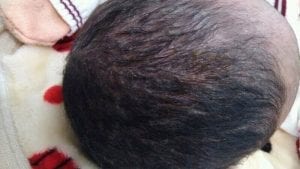
Scaly And Crusty Scalp: It is usually one of the things that parents notice immediately in a cradle cap. These scales or crust appear in the head and becomes crustier as it grows. As it grows crustier, the cap will also become flaky. Dandruff can also arise with this, but there’s usually no cause for worry.
Oily Or Dry Cap: Cradle cap can feel oily and greasy while at the same time be dry to the point that it’s flaky and crusty.
Temporary Hair Loss: If your baby loses some hair on areas where cradle caps are, don’t panic too much. This hair will eventually grow back.
Cradle caps can also be mild but still show these symptoms. Usually, cradle caps can show other signs. If these symptoms don’t seem regular, it’s time to consult a pediatrician.
Is This An Emergency Situation?
There are times when other symptoms appear along with the cradle cap, and it doesn’t seem reasonable. Check out these signs:
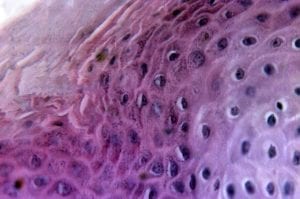
The scales are anywhere within the face and the body: Some experts like the American Academy of Paediatrics can consider these areas as areas where cradle cap can also occur. But other specialists would argue otherwise and say that the appearance of a cradle cap in these areas could be eczema, so it’s time to go to the doctor if this happens.
Irritation is visible on the cap area, mostly crusty skin: Cradle cap should not be itchy, and there shouldn’t be any irritation. The crusty skin may not be a cradle cap but a more severe sign like eczema.
The cap is swollen: Cradle caps don’t usually swell either. If it swells, then there is something wrong. Seek urgent medical attention.
Blood or yellow-like discharge from the cap area: If blood appears from the crust, then you should bring your baby to the doctor immediately. Your baby may have eczema along with a cradle cap, and a combination of these two can complicate things and lead to infections or skin cracks.
If the doctor manages to diagnose the condition of your baby, he may offer treatment.
Treatment For Cradle Cap
Now that we know the cradle cap causes, we should also discuss treatments. The cure for this condition isn’t a fit-for-all treatment. It would depend on how severe is the cradle cap on the baby. Anyway, here are some treatment ideas.
Have a head wash routine:
Most of the time, this condition can be fixed by regularly cleaning the baby’s scalp.
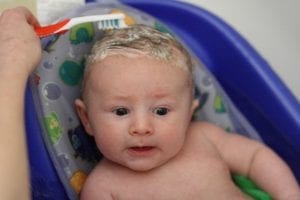
Take off the scales using a brush: When brushing your baby’s hair, do it gently, or else it can lead to infection. Don’t pick off the flakes or scales either.
Use some oil on the scalp: The purpose of using baby oil to the scalp is to connect the scales to the scalp again. Leave it on for a few minutes before combing the hair.
Wash the scalp using baby shampoo: When washing the baby’s hair, use only one shampoo. Cleanse it thoroughly too. This can help remove the scales and reduce the condition.
Pat it dry: When drying the scalp, use a soft cloth and do it gently before combing the hair.
The baby must have two hair combs or brushes. There should be one for brushing it before the bath and another one for use after washing.
If the cradle cap appears along with other conditions like eczema, the doctor may recommend a particular medicated shampoo instead.
Buy medicated shampoo formula as recommended by your doctor:
As mentioned earlier, there might be a time when the pediatrician will suggest a different type of shampoo for special cases. Use the shampoo indicated. Usually, these are only used twice or thrice a week with shampoo for babies.
Application of ointments and other relief lotions:
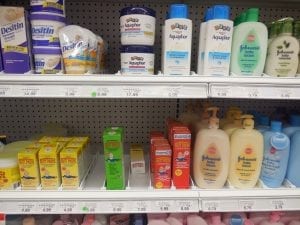
A special cream can be used on the scalp as recommended by the doctor. Do as instructed and keep up with the treatment program (more details available on MedicalNewsToday). Usually, these treatments are enough, and there are no medicines required for intake.
If your baby hasn’t experienced this yet and you want to prevent it, an excellent way to do so would be by regularly washing the scalp and hair of your baby. Use shampoo when cleaning the head. Proper hygiene and care are the best prevention. Knowing the possible cradle cap causes is a useful tool in preventing it.
Frequently Asked Questions On Cradle Cap Causes And Treatments
Last Updated on January 12, 2023 by Rejie Salazar
DISCLAIMER (IMPORTANT): This information (including all text, images, audio, or other formats on FamilyHype.com) is not intended to be a substitute for informed professional advice, diagnosis, endorsement or treatment. You should not take any action or avoid taking action without consulting a qualified professional. Always seek the advice of your physician or other qualified health provider with any questions about medical conditions. Do not disregard professional medical advice or delay seeking advice or treatment because of something you have read here a FamilyHype.com.